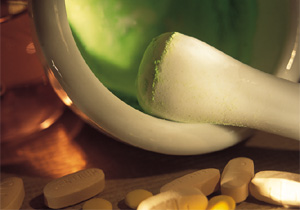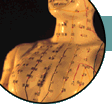Inspection
Inspection is a method to examine the patient by observation of
the expression, appearance, color, and abnormal changes of secretion
and excretion, etc.
1. Observation of the Mind
This is to observe the patient's spirit, clearness of consciousness,
coordination and vigour of movements, and keenness of response in
order to judge the excess or deficiency of yin, yang, qi, and blood
in the zang-fu organs and make a prognosis of the disease condition.
Strength of Spirit: The patient is in good spirits, the body resistance
and functions of the zang-fu organs are normal, therefore the patient
has a good prognosis. Generally speaking, the patient is in good
spirits, behaves normally with a sparkle in the eye, and has a keen
response.
Loss of Spirit: The patient is spiritless, indifferent in expression,
has dull eyes and a sluggish response, or may even be unconscious or
have a mental disturbance. This shows damage to the body resistance,
a severe disease condition, and a poor prognosis.
2. Observation of the Complexion
Observe the color and luster of the facial region. Generally,
a lustrous complexion with normal color indicates ample qi and
blood, and a mild disease with a good prognosis. If the complexion
is deep in color and withered, this indicates a serious disease
condition with damage to the qi and essence, and a difficult treatment
with poor prognosis.
White Color: A white color is the sign of a qi and blood deficiency.
A pale complexion indicates a yin excess with yang deficiency. A qi
deficiency manifests a lusterless and pale complexion and is
accompanied by swelling. A pale emaciated face indicates a blood
deficiency. A sudden pale complexion with cold sweat is the sign
of sudden prostration of yang qi due to febrile diseases caused by
exogenous pathogenic wind-cold.
Yellowish Color: a yellowish color is the sign of spleen deficiency
and damp accumulation. A complexion that is yellowish, withered and
lusterless indicates a qi deficiency of the spleen and stomach. A
yellowish, flabby complexion is the sign of damp accumulation due to
spleen dysfunction of transportation and transformation. The yellow
color of the face, eyes, and skin indicates jaundice. In traditional
Chinese medicine a bright orange yellow is diagnosed as yang jaundice
caused by pathogenic damp-heat; dark yellow in yin jaundice due to
pathogenic cold-damp.
Red Color: Redness indicates excessively full blood vessels due to
excessive heat. A red complexion is mostly due to the fever of a
common cold, or may be a heat syndrome due to excessive yang in the
zang-fu organs. Malar flush with bright red color indicates xu heat
syndromes due to yin deficiency and yang preponderance.
Bluish Color: Bluish color indicates syndromes of cold, pain, and
blood stasis or convulsion, and is the manifestation of qi and blood
obstruction in the channels. Pathogenic cold causes stagnation of qi
and blood leading to pain. Children's high fever also shows a bluish
complexion, the symptoms of acute convulsion.
Black Color: Black color indicates kidney deficiency, humor
accumulation, and blood stasis. This is the manifestation of
excessive cold and water, or stagnation of qi and blood. If the
complexion is as black as bronze, it is mostly due to an extreme weakness
of kidney yang and cold accumulation manifesting as xu-cold syndromes.
A dark dray color around the eyes denotes phlegm-humor syndrome due to
kidney deficiency. This leads to a dysfunction of the water metabolism
or leukorrhea, due to the downward flowing of kidney essence. A dark
gray malar can be seen in patients with frequent urination due to
kidney deficiency. A dark gray complexion indicates prolonged
stagnation of blood such as a consumptive disease with blood deficiency
accompanied by menoplania or amenia.
3. Observation of the Tongue
Tongue Proper
Pale Tongue: Indicates xu and cold syndromes or symptoms due to
yang qi deficiency and insufficiency of qi and blood.
Red Tongue: Indicates heat syndromes, mostly shi types of
disease caused by interior heat, or symptoms of fire preponderance
due to yin deficiency.
Deep Red Tongue: Denotes the excessive heat seen in febrile
disease due to invasion of exogenous pathogenic heat which as been
transmitted from the exterior to the interior of the body. It also
can be seen in miscellaneous diseases due to a preponderance of fire
caused by yin deficiency, or seen in diseases of accumulated fire in
the liver channel.
Purplish Tongue: Shows the syndrome of blood stagnation. A tongue
with purplish spots or petechiae also indicates blood stagnation.
Tongue Appearance
Flabby Tongue: A flabby tongue body with teeth marks on the margin
and pale in color indicates a yang deficiency of the spleen and
kidney leading to accumulation and obstruction of phlegm-dampness.
A flabby tongue with a deep red color indicates excessive pathogenic
heat attacking the heart and spleen.
Thin and Small Tongue: This indicates consumption and deficiency
of blood and yin. A thin and small tongue with a pale color denotes
deficiency of both qi and blood. A thin dry tongue with a deep red
color is mainly due to a preponderance of fire and great exhaustion
of body fluids.
Rigid Tongue: Seen in febrile diseases due to the invasion of
exogenous pathogenic heat transmitted into the pericardium or due
to an obstruction of pathogenic phlegm. It may also be seen in high
fever leading to consumption of body fluids and preponderance of
pathogenic heat. It is a prodrome of wind-stroke (cerebral stroke).
Deviated Tongue: This is a prodrome of wind-stroke.
Cracked Tongue: Cracks on the tongue with deep red color indicate
excessive heat. A cracked pale tongue indicates insufficiency of yin
and blood. However, a cracked tongueof long term duration without any
other symptoms can be considered normal.
Tongue Coating
In the first place, the properties of tongue coating should be
examined.
Thinness and Thickness: Generally, if substantial pathogenic
factors such as damp, phlegm or food accumulation occur and cause
obstruction, they further affect the spleen and stomach leading to
the ascent of turbid qi and forming of a thick tongue coating. A
white thin tongue coating is formed if nonsubstantial pathogenic
factors such as wind, heat, dryness, or cold attack the body; or
if the pathogenic factors stay on the body surface; or if body
resistance is weak during the disease development.
Moistness and Dryness: The normal tongue coating is moist,
which indicates that plenty of body fluid is flowing upward.
If the tongue coating is dry, it is due to body fluids failing
to moisten the tongue. A dry tongue coating may also be present
in some febrile diseases where pathogenic heat consumes the body
fluid. A slippery tongue coating may be due to pathogenic damp-humor
floating over the tongue surface.
Sticky and Curdled Tongue Coating: A sticky coating is due to
hyperactivity of endogenous pathogenic phlegm and damp rising to
the tongue, and is mostly seen in diseases caused by pathogenic damp-heat
or phlegm-humor. A curdled tongue coating is the outcome of food
accumulation in the stomach leading to the ascent of turbid qi to the
tongue surface. It is also seen in disease caused by phlegm-damp.
Peeled Tongue Coating: Mostly due to deficiency of qi and yin.
If peeled tongue is accompanied by a sticky coating, it indicates a
complicated disease condition to which the body resistance is weakened.
No Tongue Coating: Changes in the tongue coating indicate fluctuation
in the disease condition. For example, if a qi deficiency of the
stomach is manifested by no tongue coating at an early stage, the tongue
coating will reappear after the stomach qi is recovered. If a disease
has no tongue coating, then suddenly appears, this indicates a perversive
flow of stomach qi, or excessive pathogenic heat. If a disease has a
tongue coating at the beginning which disappears abruptly, this
indicates stomach yin fluid has decreased. If a thick coating gradually
turns into a thin white coating, this indicates that pathogenic qi is
being gradually weakened, and the disease condition is becoming milder.
Generally, an observation of the thinness and thickness of the tongue
coating will indicate the depth of pathogenic qi. The tongue's
moistness or dryness shows the body fluid condition. The degree of
curdling and stickiness of the tongue coating indicates the dampness
of the stomach and spleen. The appearance or disappearance of tongue
coating signified the cure or worsening of the disease condition.
Color of Tongue Coating
White Coating: Indicates exterior-cold syndromes. A white and
thin coating is seen mostly in exterior syndromes, while a white
and thick coating appears in interior-cold syndromes. If there is
a powder-like whitish coating covering the tongue surface, it is
caused by the internal accumulation of summer-humid heat and is
usually seen at the onset of pestilential diseases.
Yellow Coating: Indicates interior and heat syndromes. A light
yellow tongue coating is seen in cases of slight fever. A deep yellow
color indicates high fever. Brownish tongue coatings represent an
accumulation of pathogenic heat.
Grayish Coating: Denotes interior-heat syndrome or interior-cold
syndrome. A grayish black and slippery coating on the tongue usually
indicates symptom-complex due to cold-damp in the interior. A grayish,
yellow, and sticky tongue coating usually indicates the accumulation
of damp-heat. Grayish and dry tongue coatings are usually due to the
consumption of body fluid by excessive heat.
Black Coating: This is often seen at the serious and dangerous
stage of disease, and indicates extreme heat or cold. A black, yellow,
and dry coating with thorns on the tongue surface usually denotes
consumption of body fluid by extreme heat. A black and slippery
tongue coating shows excessive cold due to yang deficiency.
| 
 This website is published, edited and designed by Raymond Cheng,
and reflects only and only his personal views and opinions in his individual capacity.
The information available at this website is not intended
directly or by implication to either diagnose or treat any
medical, emotional, or psychological condition or disorder.
It is also not intended to create a physician-patient relationship
between you and I or between you and Wyith Institute™ and The Office of Dr Raymond K K Cheng.
The information here is not a substitute for advice and treatment provided
by your physician or by another healthcare professional.
It is always recommended that consultation with local healthcare providers
be obtained for any of your specific health or medical concerns.
Furthermore, any products that can be purchased (yet you can see I don't have much
to sell here) through advertisers' banners or through links to other websites
are not either explicitly or implicitly given any warranty or endorsement
by me, my colleagues, Wyith Institute™ or any of its associated businesses.
This website is published, edited and designed by Raymond Cheng,
and reflects only and only his personal views and opinions in his individual capacity.
The information available at this website is not intended
directly or by implication to either diagnose or treat any
medical, emotional, or psychological condition or disorder.
It is also not intended to create a physician-patient relationship
between you and I or between you and Wyith Institute™ and The Office of Dr Raymond K K Cheng.
The information here is not a substitute for advice and treatment provided
by your physician or by another healthcare professional.
It is always recommended that consultation with local healthcare providers
be obtained for any of your specific health or medical concerns.
Furthermore, any products that can be purchased (yet you can see I don't have much
to sell here) through advertisers' banners or through links to other websites
are not either explicitly or implicitly given any warranty or endorsement
by me, my colleagues, Wyith Institute™ or any of its associated businesses.



 Thank you for visiting this TCM and acupuncture information website.
If you have previously been to this website, you might have
noticed that some of the pages on ancient historical ideas and
holistic thinkings related to Chinese metaphysics are temporarily taken offline.
This is because I will be revamping the whole website and be moving
those information into a new \"Ancient Chinese Culture\" section
so as to reflect a more current perspective on the interpretation
of some of the fundamental concepts as well as to include
some of the latest information in the area.
But if you have just found this website for the very first time, I welcome you again and
wish you could find what you require and, hopefully, you could also be benefitted
from reading the articles I published on this website.
Thank you for visiting this TCM and acupuncture information website.
If you have previously been to this website, you might have
noticed that some of the pages on ancient historical ideas and
holistic thinkings related to Chinese metaphysics are temporarily taken offline.
This is because I will be revamping the whole website and be moving
those information into a new \"Ancient Chinese Culture\" section
so as to reflect a more current perspective on the interpretation
of some of the fundamental concepts as well as to include
some of the latest information in the area.
But if you have just found this website for the very first time, I welcome you again and
wish you could find what you require and, hopefully, you could also be benefitted
from reading the articles I published on this website.